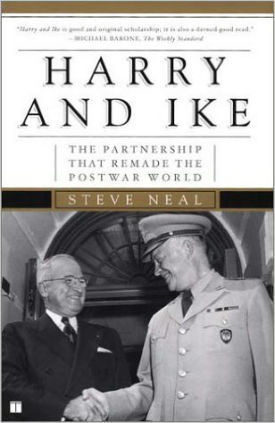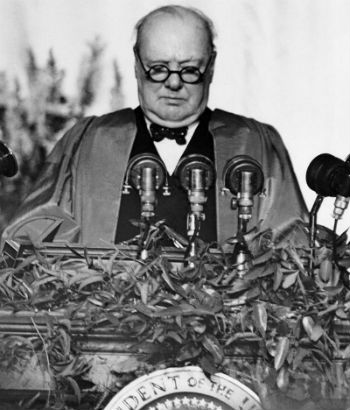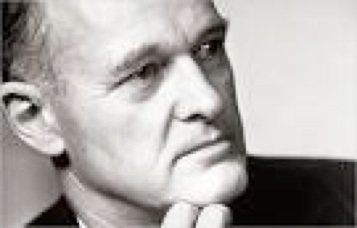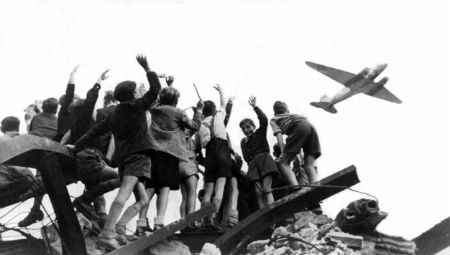The World America Made – 1944-1950
By Neil Earle

I was asked to give a talk on June 1 to the Sons of the American Revolution in Torrance, CA. They were actually formed ahead of the far-better known “Daughters of the American Revolution.” The June talk was a reprise of a lecture I had given at Duarte Public Library in 1945 to commemorate the end of World War Two. You can read what a retired marine Colonel had to say about it here.
Russians brazenly slicing off Crimea; their troops fighting in eastern Ukraine; nuclear-armed North Korea sending off missiles to intimidate Japan; Chinese naval bases growing in the South China Sea; Iran out of view after a controversial nuclear deal; car bombings harassing Baghdad – it seems things are not going right very much for American diplomacy overseas.
With an M.A. in American history I thought 1945-2015 was a good time to celebrate perhaps in succinct outline form what was perhaps the most creative and constructive period ever in U.S. Diplomatic History – the early Cold War years. The accompanying handout covers the gist of it except for a few follow-up facts.
 Truman and Stalin, 1946
Truman and Stalin, 1946Alliances of Necessity
It is easy to forget, looking back, how much Anglo-American populations were still enamored of the Russian Army and people in the years immediately following the war. The Red Army had paid a staggering price on its invincible rumble across Eastern Europe to crush Nazi Germany – losing one million soldiers just to conquer Romania.
The wartime propaganda had done its work and it was customary for American and Canadian audiences to applaud when Marshall Stalin appeared on the newsreels. Yet the new U.S. President Harry S. Truman (1945-53) and the recently deposed British leader Winston Churchill and their aides and confidants knew all was not well. Russian troops still stayed in northern Iran having moved to guard the oil fields with British support, threats were being made against Turkey’s sea base of the Dardanelles, a Tsarist goal of control for centuries, and immense Communist parties were marching and agitating in Greece, France and Italy – an early example of what has been called “hybrid war” under Putin. Europe’s Southern flank appeared in tatters. Worse, the Soviets were not accepting the legitimate pre-war government of Poland that had fled into exile to London in 1939.
 Churchill's Iron Curtain Speech, 1946
Churchill's Iron Curtain Speech, 1946“Words of One Syllable”
Thus in January, 1946 President Harry S Truman called in Soviet Foreign Minister Molotov and lectured him in “words of one syllable.” Harry Truman had been captain of an Irish-American company in WW1 and there were few swear words he didn’t know – or use. When Molotov complained he’d never been talked to like that, Truman said, “Keep your obligations and you won’t have to be.”
The next month, February, 1946 Truman invited Winston Churchill to speak at Fulton, Missouri and out came the famous ”Iron Curtain” speech. “From Stettin in the Baltic, to Trieste in the Adriatic, an Iron Curtain has descended across the continent,” Churchill declaimed. Still, the attempt to wake up the Anglo-American powers was not received well everywhere. Even young Congressman Richard Nixon thought Churchill had gone too far at first until a Soviet espionage scare erupted in the US in 1948.
William Manchester later wrote that the U.S. Sixth Fleet was born on that visit to Fulton as Truman’s advisors cleverly schemed to send a recently deceased Turkish ambassador back to Turkey but escorted by the U.S.S. Missouri and a naval task force. This was the way the Cold War game would be played – letting your adversary know you were mightily concerned, still around, ready to give support, going to the brink of war but never quite crossing the line.
Even before all these events, international financial planners had met in Bretton Woods, NH to create the World Bank and the International Monetary Fund, designed to act like first-responders in the event of worldwide economic breakdown such as had happened in the 1930s. The United States was accumulating 60% of the world’s gold so it could make the rules. As it turned out, the conference set the price of gold at $35 an ounce and thus ensured price stability worldwide up till the 1970s. The foundations of our present economic order pivoting on the dollar were set. President Dwight Eisenhower (1953-61) would later say that the American economy was the country’s first line of defense.
 Secretary of State George Marshall
Secretary of State George MarshallTruman Doctrine and Marshall Plan
In The Glory and the Dream William Manchester claims it was possible to fix the time and place when the flag of world leadership began to pas from the dying British Empire to the United States. Friday, February 21, 1947 the British ambassador telephoned the State Department in Washington to request a meeting. The upshot was the British could no longer prop up Greece against Communist subversion and Turkey was also in trouble. The bitter winter had drained London of its reserves. Could the United States do something?
Thus it was on March 12, 1947 that Truman asked Congress for $400 million for aid and reconstruction to Greece and Turkey. It was the Truman Doctrine – the United States would move to help countries threatened by external subversion. The Republican Congress acceded. Truman signed the aid package on May 22. It worked. Give people the tolls to bail themselves out. Just the next month Secretary of State Marshall launched the European Recovery Program with a speech at Harvard. Now the U.S. was really involved, over the next few years 13-19 billion dollars in aid flowed to rebuild shattered Europe. Even the Russians were invited but declined. Churchill heralded ERP as ”the most unsordid act in history” – a giant stride from a country that had cancelled lend-lease aid to its former allies already.
 George Kennan, Moscow expert (1947)
George Kennan, Moscow expert (1947)End of Normalcy
There would be no going back to normal after this. On June 24, 1048 Soviet puppets in East Germany closed rail and road lines into the city of West Berlin run by the former Allies since 1945. What to do? Force the supplies through and risk WW3? The British RAF came up with the idea of an airlift, and in the next year 18,000 tons of food a day arrived on C-54’s and C-57s and with a distressing loss of aircrew lives. But Operation Vittles – from June 1948 to May 1949 was a colossal propaganda and strategic victory for the Anglo-American powers. On top of that Operation Little Vittles – Allied airmen dropping candy and toys from the windows of their planes at their own expense – sealed the deal. Americans were now ten foot tall in Western Europe.
 Berlin Airlift, 1948-49
Berlin Airlift, 1948-49By the time the Russians exploded their own A-Bomb in August 1949 and China went Communist there was something more than foreign aid in place. On April 4, 1949 12 nations signed the North Atlantic Treaty Organization in Washington. It was the first peacetime military alliance entered into by the U.S. The days of the 1930s – of Neutrality Acts and abandoning the old League of Nations – these were over. American stepped forth to lead what became known as the Free World and our present age of American dominance and consultation on major issues and even tragedies was born. We still live in the world America made.